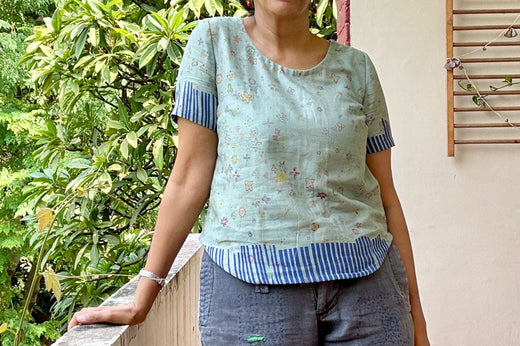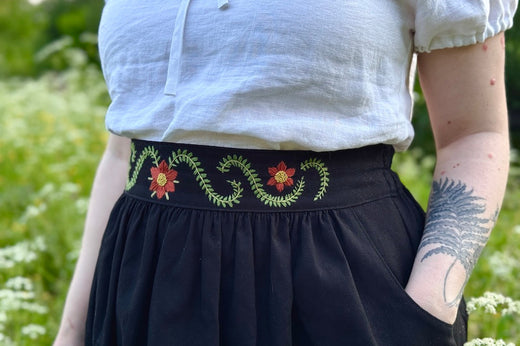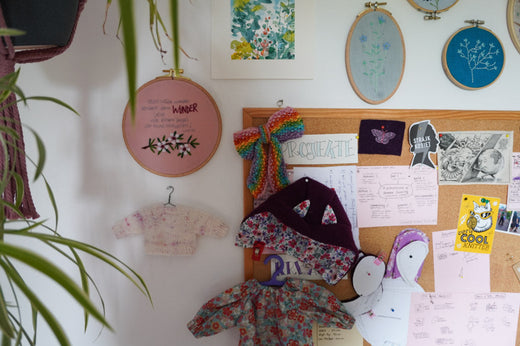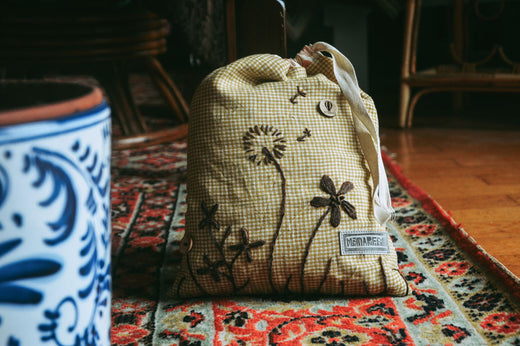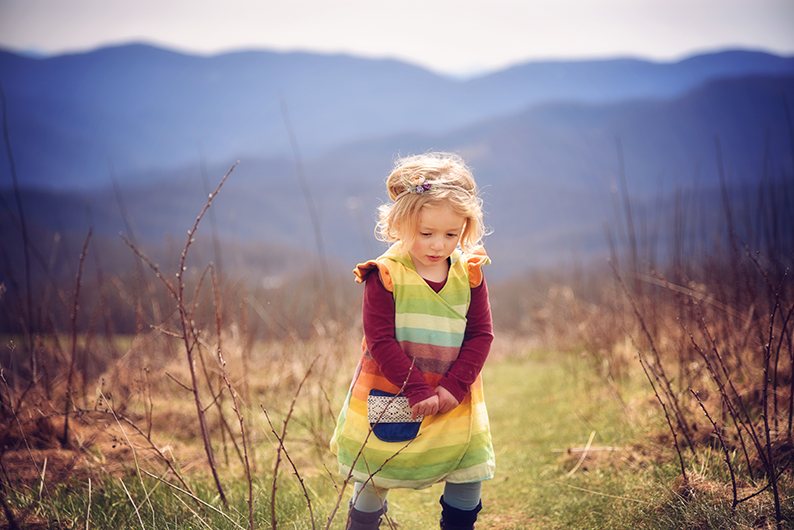We are so pleased to welcome Twig + Tale Storyteller Elisa Tavares to the blog this month. Descended from a Cape Verdean family with a strong tradition of fibre arts, Elisa is sharing a story about family, textile traditions, and her own identity as a maker.

Identity is a very big word that encompasses so many different aspects. I always associate identity with tradition, with lived experiences that shape the way you see and navigate the world. When I think about my identity, I inevitably think about who and where I came from. Let me introduce myself briefly: My Name is Elisa. I was born in Lisbon to Cape Verdean parents that had left their home island of Santiago in the 1970's and headed to Portugal in search of a better life. I grew up and lived in Lisbon until I was 23. At this point I went to Germany for what was supposed to be a 6 month internship... That was almost 20 years ago and I'm still here. Let's just say I met a boy and the rest is history.
Growing up I always felt like I lived in two parallel worlds. The "outside" Portuguese world and the "in the house" Cape Verdean world full of the creole stories, tastes, traditions and the language of the homeland. We humans tend to like having categories and labels to sort things out and so I often questioned my identity. Which box do I fit in? Living in Germany for nearly 2 decades, a country where the vast majority of the population looks nothing like me, and now having a mixed family of my own added another level of complexity to the matter. It took me a while to get this, but I can tell you now that sewing is one of the key pieces of my identity puzzle.
Here's a little bit of history: the archipelago of Cape Verde was inhabited when it was discovered by the Portuguese in 1462. A very dark period followed, with West Africans being enslaved and forcefully brought by the Portuguese to the islands and afterwards being traded for goods or sold and sent off to do forced work in the Americas or in Europe. As the centuries went by, the Cape Verdean people originated from European (mostly Portuguese) settlers and descendants of enslaved Africans (this is a very simplified synopsis!). The main island of Cape Verde – Santiago – was always the island with the most African population and to this day traces of that rich heritage can be found.
One of those traces is the panu di téra (the cloth of the land), consisting of several narrow woven strips sewn together. The traditional panu di téra was made locally out of white and indigo-dyed thread and there is a variety of designs with different names and meanings, some of them indicating the social status of the wearer. The women wore the panu di téra on any given occasion. Certainly on the most special days, but also in their everyday life, wrapped around their waist or hips, over the shoulders on more chilly days or as a light cover on an overnight stay. This woven cloth was so valuable, that in the early days of colonization it was used as a currency to buy goods and even in the trade of slaves. My mother, who is in her 70's, recalls that in her childhood and youth the panu di téra was seen as one of the most precious possessions of a Santiago woman. It was a matter of pride in the traditions of the land and in the identity of their people. If your daughter was getting married and you didn't have the means yourself to give her the customary panu as a dowry, friends and neighbors would chip in to make sure she would be sent off to her new household as the tradition required.
Another ancestral tradition that still lives on is the batuku, a genre at the crossroads of oral literature, music and dance, usually performed by a group of women sitting in a semi-circle with rolled-up cloths held between their thighs, on which they beat contrasting rhythmic patterns, creating a very characteristic poly-rhythmic texture. Batuku and the panu di téra are inextricably intertwined. The panu was always a staple of the batukaderas, the female performers of batuku. After the country gained its independence in 1975, in an effort to revive the creole traditions that had been suppressed by the Portuguese, the new regime promoted public batuku performances in the capital, Praia. The goal was to bring the rural traditions to the population in the city in order to combat the cultural alienation of the colonial period. This marks simultaneously the revival of the panu di téra and a new found love of Cape Verdeans for its artisans. This celebration of the African heritage continues with a new generation of designers now integrating strips of panu di téra in their garments and accessories and making this traditional item fashionable.
 Examples of panu di téra
Examples of panu di téra
I can only trace my roots a few generations back, but I was pleased to find out that fibre arts run in my family. I come from a line of weavers both on my mother's and on my father's side. My great-grandfather, who they called Father César (his actual name was Luís Mendes Tavares), was known for his artistry. My grandfather Domingos and his brothers learned the art of weaving from their father and were also skilled artisans, being featured in local books and newspaper articles. For a long time, every year around the independence day on July 5th my great-uncle Sabino would be invited to travel to the capital and give demonstrations of his craft. His brother, my great-uncle Damásio, even travelled to the other islands to teach workshops.

 Elisa's great-uncle Sabino weaving
Elisa's great-uncle Sabino weaving
Sadly, the women of the family were not taught to weave. At least not as intentionally as the men, although they were very much involved in the many production steps of the panu di téra. Many of the women in the family learned how to do lace crochet. My mother was one of them. She was never formally trained, she just learned by watching others do it. As a kid I was fascinated to see how she would hold a piece of crocheted lace that someone else had made, carefully study it and after a few tries she would figure out the crochet pattern that person had used and was able to recreate the original piece or make it into her own. Talk about pattern hacking! All my life I remember her quick hands turning the most intricate patterns into beautiful decorative pieces, table runners, bed covers, etc.
We still have the sewing machine my father gifted her when she first got to Portugal. My mother sewed pretty much every single curtain we ever had in our house, she also made bed linens and table cloths and occasionally made alterations, but garment sewing was never her thing. Her passion still is crochet and I think she is masterful.
 Crochet work by Elisa's mother (above), and her sewing machine (below)
Crochet work by Elisa's mother (above), and her sewing machine (below)

Although I only came to sewing in the last 10 years or so, I like to think that my ancestors and I are bonded by a special thread that is the appreciation for fiber arts and for tradition. This is part of my identity and something I want to explore even more in the future. Maybe it has to do with the fact that I'm getting older, but I feel that I need to know more about who my people were and where they came from. I want to keep our family thread alive by remembering and celebrating the ones that came before me. I am someone who appreciates perfectly imperfect handmade items. I love repurposing fabric from clothes that no longer fit, have stains or are otherwise damaged and giving them a second (or third) life. I like to sew mindfully and I'm the most proud when a project is meaningful and has a story to tell.
Just like the Wayfarer shoes that I made as my July/August project in the Twig + Tale Storytellers team. I made a pair for myself and one for my son. This was a special project because of the materials I used. The outer fabric of my shoes and the lining of my son's are souvenirs (my favourite kind) from a visit to England last year. I went to a thrift store and got a whole bag of high quality upholstery remnants for only a pound or so. This is some very fancy linen. The lining of my shoes is a thrifted pillow case. The leather that I used on both shoes belonged to my father-in-law and was given to me when he passed away a few years ago. He learned the trade of a saddler and still had a collection of different types of leather. This is my way of honouring him and keeping his memory alive. I had challenged myself to finally learn how to embroider and was able to make some embroidery on my son's shoes. It was not easy getting the needle through the leather, but this project made me slow down and I really enjoyed the process.


This was a long post, but if you got to this point I really hope you enjoyed learning a bit more about me and my family. Happy sewing, friends!


See more of Elisa's sewing here.
Read more articles from the Twig + Tale Storytellers here.

